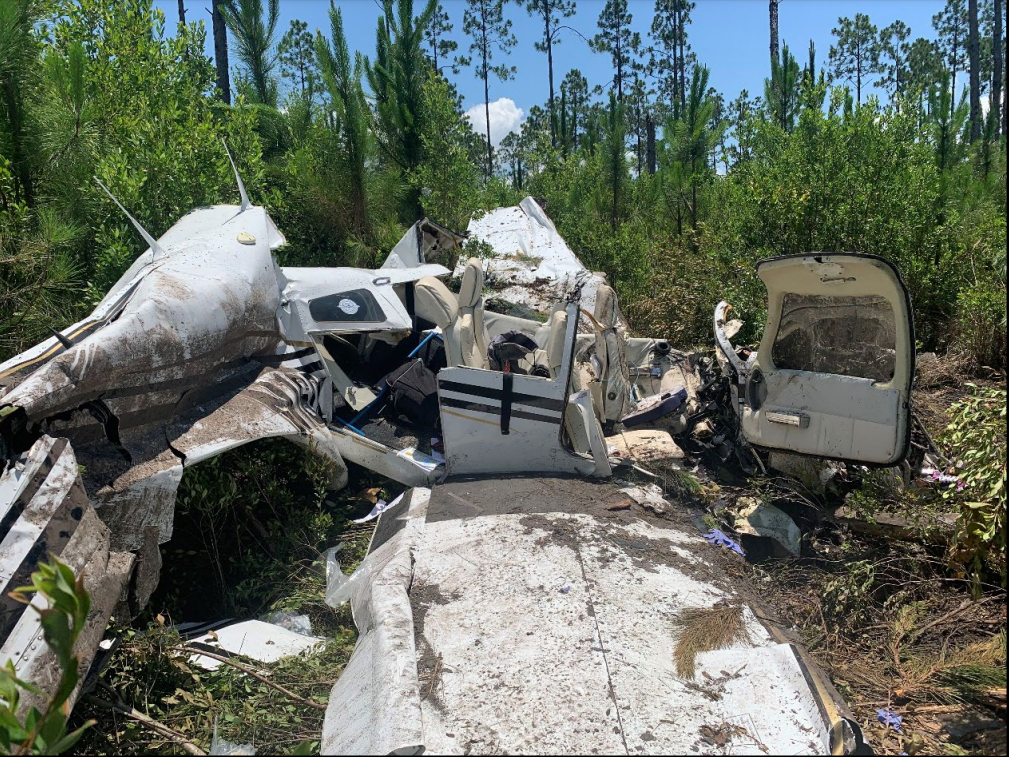
ASN Wikibase Occurrence # 279066
This information is added by users of ASN. Neither ASN nor the Flight Safety Foundation are responsible for the completeness or correctness of this information.
If you feel this information is incomplete or incorrect, you can submit corrected information.
| Date: | Monday 6 June 2022 |
| Time: | 16:10 |
| Type: |  Piper PA-28RT-201 Arrow IV |
| Owner/operator: | Registration Pending |
| Registration: | N160LL |
| MSN: | 28R-7918157 |
| Year of manufacture: | 1979 |
| Total airframe hrs: | 3956 hours |
| Fatalities: | Fatalities: 2 / Occupants: 3 |
| Aircraft damage: | Destroyed |
| Category: | Accident |
| Location: | near Northwest Florida Beaches International Airport (KECP/ECP), FL -
 United States of America United States of America
|
| Phase: | Initial climb |
| Nature: | Private |
| Departure airport: | Panama City-Northwest Florida Beaches International Airport, FL (ECP/KECP) |
| Orlando Executive Airport, FL (ORL/KORL) | |
| Investigating agency: | NTSB |
| Confidence Rating: |
On June 6, 2022, about 1610 central daylight time, a Piper PA-28RT-201, N160LL, was substantially damaged when it was involved in an accident near Northwest Florida Beaches International Airport (ECP), Panama City, Florida. The pilot and one passenger were fatally injured, and another passenger sustained serious injuries. The airplane was operated as a Title 14 Code of Federal Regulations Part 91 personal flight.
The pilot was conducting a personal flight with two passengers aboard. Security camera video revealed that when the pilot arrived at the airplane prior to initiating the flight, he did not perform a complete preflight inspection, which should have included at least a cursory examination of the airplane’s engine and a check of the ground below it. Shortly after departure, the pilot declared an emergency, and the airplane made a 180° left turn back toward the airport. The airplane descended and impacted terrain about 1.7 miles from the runway threshold.
Postaccident examination of the engine revealed that the crankcase was breached near the No. 4 cylinder. Also, the No. 4 connecting rod journal exhibited thermal damage and bearing material was found welded/smeared to the crankshaft journal. The No. 4 connecting rod cap, connecting rod bolts, and bearing pieces were found in the oil sump along with other metallic debris and a trace amount of oil. Examination of the oil system revealed that the oil pressure sensor was separated from the engine. The sensor’s rigid copper line was fractured at the fitting to the accessory section of the crankcase. The propeller exhibited chordwise scratching and angle-cut tree branches in the vicinity of the wreckage, which were indications that the engine did not lose total power.
Examination of the rigid oil pressure line revealed that it fractured due to high-cycle fatigue. This was likely from excessive vibration due to insufficient support of the oil pressure sensor and rigid line. The oil pressure sensor, which was part of the avionics system, was installed about 3 flight hours before the accident. The installation manual for the avionics system stated that a flexible line should be used to install the oil pressure sensor in order to minimize vibration effects. Instead, a rigid line was installed, which would have been more susceptible to the effects of vibration, including high-cycle fatigue failure.
Oil staining observed on the ramp area where the airplane was parked before the flight, a trail of oil leading from the parking area to the runway, and the oil observed on the airframe exterior at the accident site all suggest that the airplane was actively leaking oil both before and during the accident flight. Based on all available information, it is likely that the oil pressure sensor line fractured during the flight before the accident flight, which resulted in oil leaking from the engine. This oil leak ultimately resulted in oil starvation and loss of engine power during the departure from, and the pilot’s attempted return to the airport. Had the pilot noted and investigated the source of the oil leakage during the preflight inspection, he might have taken appropriate corrective action and avoided the accident
Probable Cause: Maintenance personnel’s failure to follow the avionics installation guidance for the oil pressure sensor, which resulted in the high-cycle fatigue failure of an line, oil starvation, and the subsequent loss of engine power. Contributing to the accident was the pilot’s failure to perform an adequate preflight inspection of the airplane.
Accident investigation:
 |
|
Sources:
https://www.wjhg.com/2022/06/06/plane-crashes-near-northwest-florida-beaches-international-airport/?fbclid=IwAR3E-KBAwv1GTtj8yrWgnNvMKuQZaqfgQ6ggeUv6MP6xxwXzvQVaGushi_s
https://data.ntsb.gov/Docket?ProjectID=105200
https://registry.faa.gov/AircraftInquiry/Search/NNumberResult?nNumberTxt=160LL
https://flightaware.com/live/flight/N160LL/history/20220606/2136Z/KECP/KECP
https://globe.adsbexchange.com/?icao=a0f2b3&lat=30.316&lon=-85.781&zoom=13.7&showTrace=2022-06-06&trackLabels
https://photos-e1.flightcdn.com/photos/retriever/606d88a16cbb267d754790c76519db2d82e9727a (photo)
History of this aircraft
Other occurrences involving this aircraft
| 18 May 1989 | N29241 | Flight Safety Int'l, Inc. | 0 | Melbourne, FL |  |
sub |
Location
Images:

Photo: NTSB
Revision history:
| Date/time | Contributor | Updates |
|---|---|---|
| 06-Jun-2022 23:18 | Captain Adam | Added |
| 07-Jun-2022 01:03 | Captain Adam | Updated [Time, Aircraft type, Registration, Cn, Operator, Total occupants, Location, Destination airport, Source, Narrative, Category] |
| 07-Jun-2022 02:48 | RobertMB | Updated [Time, Aircraft type, Location, Nature, Source, Damage, Narrative] |
| 18-Jun-2022 02:06 | Captain Adam | Updated [Time, Destination airport, Source, Narrative, Category] |
| 21-Sep-2023 19:47 | Ron Averes | Updated [[Time, Destination airport, Source, Narrative, Category]] |
| 11-Nov-2023 23:49 | Captain Adam | Updated [Location, Source, Narrative, Accident report, Photo] |
Corrections or additions? ... Edit this accident description
The Aviation Safety Network is an exclusive service provided by:


 ©2024 Flight Safety Foundation
©2024 Flight Safety Foundation